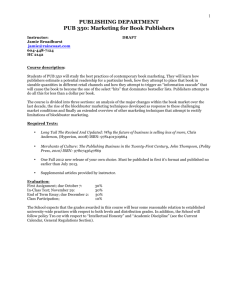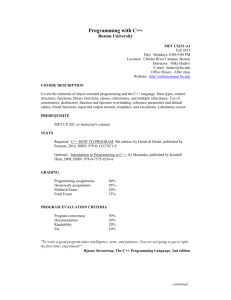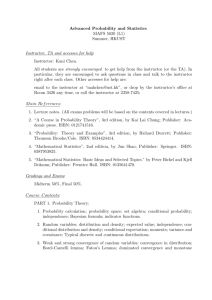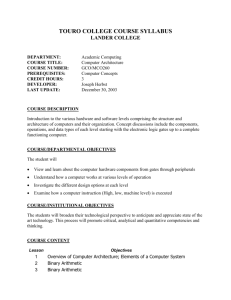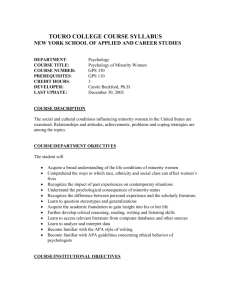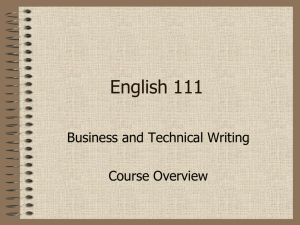GCA.166 - Touro College
advertisement
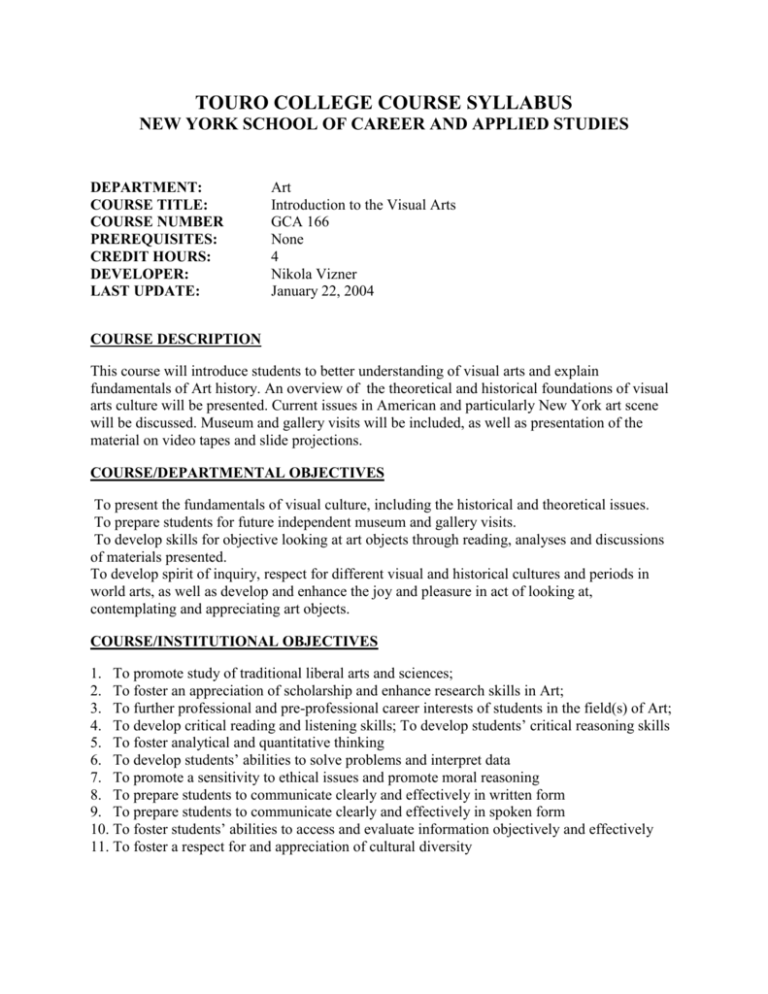
TOURO COLLEGE COURSE SYLLABUS NEW YORK SCHOOL OF CAREER AND APPLIED STUDIES DEPARTMENT: COURSE TITLE: COURSE NUMBER PREREQUISITES: CREDIT HOURS: DEVELOPER: LAST UPDATE: Art Introduction to the Visual Arts GCA 166 None 4 Nikola Vizner January 22, 2004 COURSE DESCRIPTION This course will introduce students to better understanding of visual arts and explain fundamentals of Art history. An overview of the theoretical and historical foundations of visual arts culture will be presented. Current issues in American and particularly New York art scene will be discussed. Museum and gallery visits will be included, as well as presentation of the material on video tapes and slide projections. COURSE/DEPARTMENTAL OBJECTIVES To present the fundamentals of visual culture, including the historical and theoretical issues. To prepare students for future independent museum and gallery visits. To develop skills for objective looking at art objects through reading, analyses and discussions of materials presented. To develop spirit of inquiry, respect for different visual and historical cultures and periods in world arts, as well as develop and enhance the joy and pleasure in act of looking at, contemplating and appreciating art objects. COURSE/INSTITUTIONAL OBJECTIVES 1. To promote study of traditional liberal arts and sciences; 2. To foster an appreciation of scholarship and enhance research skills in Art; 3. To further professional and pre-professional career interests of students in the field(s) of Art; 4. To develop critical reading and listening skills; To develop students’ critical reasoning skills 5. To foster analytical and quantitative thinking 6. To develop students’ abilities to solve problems and interpret data 7. To promote a sensitivity to ethical issues and promote moral reasoning 8. To prepare students to communicate clearly and effectively in written form 9. To prepare students to communicate clearly and effectively in spoken form 10. To foster students’ abilities to access and evaluate information objectively and effectively 11. To foster a respect for and appreciation of cultural diversity COURSE CONTENT The Bases of Art History: style, chronology, purpose, place, of origin, the artist, iconography, historical context. General Concepts: form, techniques, space, mass and volume, line, perspective, composition, proportions, scale, light, value, modeling, hue, color triangle, texture. Elements of Architecture: plan, section, elevation, spatial aspects, mass, structural problems, program of the building, elements of urbanism. Elements of Sculpture: high and low relief, free standing sculpture, tactile values, techniques, materials. The Problem of Representation: illusion, representation as a function of history and geography, “to see” and “to know” as elements of representation. Brief review of the art of ancient Near East with ancient Egypt, art of ancient Greece and Rome, Byzantine and Islamic art, art of Pre-Colombian Americas. Renaissance: sculpture, architecture, painting. Baroque and Rococo in visual arts. Neo-Classicism, Romanticism, Realism in visual arts. Impressionism and Post-Impressionism in painting. The Twentieth Century: Art Nouveau, Fauvism, Cubism, Futurism, Dada, Surrealism, Constructivism, Social Realism, art and politics. Art after World War II in the U.S.A. HARDWARE/SOFTWARE/MATERIALS REQUIREMENTS: Not Applicable COURSE REQUIREMENTS Reading of assigned chapters in the text book and class material as scheduled Participation in class discussions, museum and gallery visits, other activities Midterm report Final report Regular attendance. GRADING GUIDELINES Instructor’s observation of classroom performance and participation in class discussions. Grading of individual and group projects, including midterm and final papers. Brief in-class presentation of certain relevant topics. Both midterm and final reports require a research paper, with the topic chosen in consultation with the instructor. METHODOLOGY Lectures Class discussions Slide projections and video tapes Museum and gallery visits. Use of Internet in research. COURSE TEXT(S) Title: Author: Pub. Date: Publisher: ISBN #: Gardner’s Art Through the Ages, 9th edition Gardner 1991 Harcourt Brace College Publishers Title: Author: Pub. Date: Publisher: ISBN #: Believing is Seeing: Creating the Culture of Art Staniszewski, Mary A 1995 Penguin Books BIBLIOGRAPHY Title: Author: Pub. Date: Publisher: ISBN #: Title: Author: Pub. Date: Publisher: ISBN #: 3 TOURO COLLEGE COURSE OUTLINE NEW YORK SCHOOL OF CAREER AND APPLIED STUDIES DEPARTMENT: COURSE TITLE: COURSE NUMBER PREREQUISITES: CREDIT HOURS: SEMESTER : Art Introduction to the Visual Arts GCA 166 None 4 Fall, 2003 CLASS INFORMATION CLASS CODE: SCHEDULE: LOCATION: FINAL EXAM DATE: INSTRUCTOR CONTACT INFORMATION Instructor Name: Email Address: Contact Phone: Office Location/Hours: COURSE DESCRIPTION This course will introduce students to better understanding of visual arts and explain fundamentals of Art history. An overview of the theoretical and historical foundations of visual arts culture will be presented. Current issues in American and particularly New York art scene will be discussed. Museum and gallery visits will be included, as well as presentation of the material on video tapes and slide projections. COURSE/DEPARTMENTAL OBJECTIVES To present the fundamentals of visual culture, including the historical and theoretical issues. To prepare students for future independent museum and gallery visits. To develop skills for objective looking at art objects through reading, analyses and discussions of materials presented. To develop spirit of inquiry, respect for different visual and historical cultures and periods in world arts, as well as develop and enhance the joy and pleasure in act of looking at, contemplating and appreciating art objects. 1 COURSE REQUIREMENTS Reading of assigned chapters in the text book and class material as scheduled Participation in class discussions, museum and gallery visits, other activities Midterm report Final report Regular attendance. GRADING GUIDELINES Instructor’s observation of classroom performance and participation in class discussions. Grading of individual and group projects, including midterm and final papers. Brief in-class presentation of certain relevant topics. Both midterm and final reports require a research paper, with the topic chosen in consultation with the instructor. COURSE TEXT(S) Title: Author: Pub. Date: Publisher: ISBN #: Gardner’s Art Through the Ages, 9th edition Gardner 1991 Harcourt Brace College Publishers Title: Author: Pub. Date: Publisher: ISBN #: Believing is Seeing: Creating the Culture of Art Staniszewski, Mary A 1995 Penguin Books BIBLIOGRAPHY Title: Author: Pub. Date: Publisher: ISBN #: Title: Author: Pub. Date: Publisher: ISBN #: 2 COURSE CONTENT The Bases of Art History: style, chronology, purpose, place, of origin, the artist, iconography, historical context. General Concepts: form, techniques, space, mass and volume, line, perspective, composition, proportions, scale, light, value, modeling, hue, color triangle, texture. Elements of Architecture: plan, section, elevation, spatial aspects, mass, structural problems, program of the building, elements of urbanism. Elements of Sculpture: high and low relief, free standing sculpture, tactile values, techniques, materials. The Problem of Representation: illusion, representation as a function of history and geography, “to see” and “to know” as elements of representation. Brief review of the art of ancient Near East with ancient Egypt, art of ancient Greece and Rome, Byzantine and Islamic art, art of Pre-Colombian Americas. Renaissance: sculpture, architecture, painting. Baroque and Rococo in visual arts. Neo-Classicism, Romanticism, Realism in visual arts. Impressionism and Post-Impressionism in painting. The Twentieth Century: Art Nouveau, Fauvism, Cubism, Futurism, Dada, Surrealism, Constructivism, Social Realism, art and politics. Art after World War II in the U.S.A. ATTENDANCE & MAKE-UP POLICIES Instructor is responsible for making up any missed classes either by arranging a make up date or providing a substitute instructor. HOMEWORK ASSIGNMENTS Reading of assigned chapters in the text book and class material as scheduled 1

